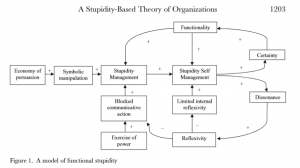TSElosophers meeting on 26th November 2024.
Participants: Erkki Lassila, Kari Lukka, Ari Nieminen, Minna-Liina Ojala, Otto Rosendahl, Mia Salo, Milla Unkila
Reading: Introduction to the Special Issue on Philosophy and Organization Studies: How Does Philosophy Illuminate the Study of Organizations? Tsoukas, H., Sandberg, J., Fayard, A-L. & Zundel, M. (2024) Organization Studies, 45(9), 1229–1251.
Summary
The aim of this introductory article is to promote and offer means for a more philosophically oriented approach to organization studies. The authors argue that philosophical inquiry concerning the meta-theoretical level of research along with philosophical intuition are needed to question extant closures of meaning, and to propose new ways of seeing and theorizing organizational phenomena, as well as the world more broadly. In addition to identifying common conceptual traps Tsoukas, Sandberg, Fayard, and Zundel also propose four ways in which philosophy can inform organizational studies: (1) Cultivating the attitude of wonder where the emphasis is on “letting the phenomena of interest reveal their own be-ing”; (2) Questioning received images of thought, that is, putting effort on evaluating our own thinking and theories we use; (3) Enabling new images of thought for theory development, where philosophical inquiry permits generating novel conceptual distinctions and thus theorizing; (4) Philosophy helps us think critically about organization and management as a ‘problem’. For example, through philosophical inquiry, we can “problematize the pervasiveness of a market logic in the context of social issues”. To conclude, the authors introduce the featured articles of the Special Issue.
Our discussion
TSElosophers found this article important, well-structured, and necessary, even though it somewhat echoes the themes that the authors have described in their previous papers, such as Tsoukas & Chia (2011). Most of all, we considered this piece a kind of wake-up call for organizational scholars to stop and think as to what kind of research each of us is conducting and how well that matches with what scholarly research should arguably be all about – for instance, most certainly not only about ‘getting published’!
Surely, we had a lively discussion. To start with, we particularly appreciated the emphasis on the importance of philosophical inquiry, that is, the meta-theoretical level of study and its legitimacy as a research approach in our field. Likewise, articulating how the development of basic scientific concepts relies on philosophical intuition is most likely a useful reminder for many. One important aspect of the possibilities of the philosophical inquiry is that it does not need to limit itself to the factual but instead can also enter the realm of the ethical. From the perspective of “an evaluative organization science” or “humanist science” (Selznick), theorizing through philosophical inquiry is necessary. Indeed, we warmly recommend this article for those organization scholars who are interested in using philosophical inquiry to generate new conceptualizations and theories.
Many of us, while reading the article, had paid attention to the frequently used term ‘closure of meaning’, which was also metaphorically depicted through Wittgenstein’s ‘fly-bottle’. The closure of meaning denotes that “specific ways of investigating the world become unquestioned and accepted as true”. We were amused by our idea of numerous (fly-)bottles in a ‘sea of reality’, where researchers jump from one bottle to another as they adopt new ways of doing research. We also decided to be hopeful that with these jumps, the ‘sight’ of science and organizational studies, for that matter, will improve. Importantly and paradoxically, as researchers, we both need these domain-specific closures of meaning or nomological networks in our research and, similarly, we ought to see beyond them at times. As Hines (1988) put it, a way of seeing is also a way of not seeing. In the paper, this dilemma was also exemplified by a movement between presence and absence – a pair of concepts whose usefulness and meaning, in general, we ended up debating.
One thing that also caught our attention was that the authors do not explicitly mention the term ‘performativity’ at all. Instead, the notion of ‘becoming’ appears numerous times. For one of us, their meanings appear similar, while a few others suggested there are notable differences. The latter turned out not that simple to articulate, however, partly due to the time limitation. Nevertheless, already during the discussion, it became evident that ‘becoming’ is the broader and more general notion of the two – but it also came to the fore how the conceptual meaning of ‘performativity’ obviously needs further thought. Hence, we concluded that philosophical inquiry is certainly needed!
Overall, we really enjoyed this paper – even though some of us were a little surprised that the authors relied heavily on the ideas of one key philosopher, namely Alfred Whitehead. That said, this can perhaps be quite easily excused when Haridimos Tsoukas features in the author team: Several of his prior works lean heavily on the process philosophy approach to organization studies.
